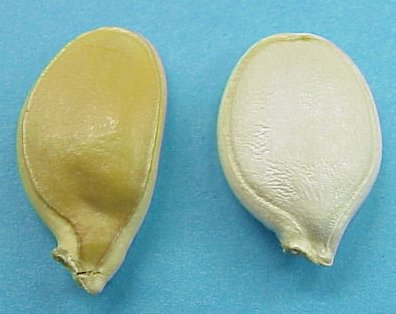Re: Questions, Questions and more Questions
I understand that most, if not all of the genotypes for AG are either not known or are
only guessed at by growers with enough exposure to form an opinion. It was, with this
in mind, that I chose to not bring the question to such a level as to prove that there
is no absolute answer, but, rather, to ask growers to pass along their hunches,
experiences and opinions, which in the absence of absolute proof, is the next best
thing. In this manner, each of us make our seed selections for the season, and judging
by the success of these crossings, clearly demonstrates the validity of such 'guest
work'. I agree that few of us have the time or money to have a lab perform DNA
testing on AG's, however, I don't agree that we can not cross for a group of traits,
like 'thick walls and weight'. Certain families of AG do exhibit specific features
that other families don't. Consider the seed types shown in the attached photo. And
having shown the photo, might I add another question?
Which pumpkins have exhibited the characteristics of the white seed shown in the
photo?
And
Which parent has the most influence with respect to fruit shape?
Which parent has the most influence with respect to fruit color?
Respectfully,
Greg Schraiber
robert fifield wrote:
> I would say that 50% comes from the male and 50% comes from the female.
> But that does not mean it show up that way in your pumpkin. e.g. lets say
> your pumpkin plant is Rr(geno type) for roundness Big R meaning round and
> little r meaning long or not so round, that means your pumpkin will be
> round. Now back to the 50-50 thing it still gets half of its genetic info
> from each parent, but in the pheno type(the pumpkin) you dont see the recessive
> trait.
> A extreme example of that would be if your take a plant that is homozygous(spell?)
>
> recessive in every trait and cross it with one that is homozygous dominate,
> the product of this cross would appear to be a 'clone' of the dominate
> one. But it would still be 50% form mom and 50% from dad, even though all
> of the visible characteristics only point to one parent.
>
> I hope this helps, this is pretty basic you still have to consider what
> kind of cross it is, just a simple Dominate a single trait shown, or Co-dominate
> like spotted cows both colors show up, or In-complete dominate like red
> and white flowers make pink ones.
>
> P.S. I have found that there is very little info out there on pumpkin
> genetics, even if there was I dont thing the average grower would have
> enough time or money to have a lab study pumpkin DNA or years trying to
> purify a trait or group of traits.
>
> Greg Schraiber wrote:
>
> > Here are a few questions for the list..
> >
> > Plant 'A' (the female) is pollinated with pollen from a different plant, plant
> > 'B' (the male), and grows a pumpkin which contains 100 seeds. When those seeds
> > are grown, the resulting fruit will display characteristics of it's parents.
> >
> > Which parent has the most influence with respect to shape?
> > Which parent has the most influence with respect to color?
> >
> > Thanks,
> > Greg
> >
> > ---------------------------------------------------------------------
> > Pumpkin-growing FAQ: http://www.mallorn.com/lists/pumpkins/search.cgi
> > To sign-off this list, send email to majordomo@mallorn.com with the
> > message text UNSUBSCRIBE PUMPKINS
>
> ---------------------------------------------------------------------
> Pumpkin-growing FAQ: http://www.mallorn.com/lists/pumpkins/search.cgi
> To sign-off this list, send email to majordomo@mallorn.com with the
> message text UNSUBSCRIBE PUMPKINS



